NCERT Solutions For Class 4 Maths Chapter 1 - Building With Bricks
The chapter Building with Bricks deals with tiling and floor patterns, and helps the students to identify lines of symmetry in shapes.
Download PDF For NCERT Solutions for Maths Building with Bricks
The NCERT Solutions For Class 4 Maths Chapter 1 - Building With Bricks are tailored to help the students master the concepts that are key to success in their classrooms. The solutions given in the PDF are developed by experts and correlate with the CBSE syllabus of 2023-2024. These solutions provide thorough explanations with a step-by-step approach to solving problems. Students can easily get a hold of the subject and learn the basics with a deeper understanding. Additionally, they can practice better, be confident, and perform well in their examinations with the support of this PDF.
Download PDF
Access Answers to NCERT Solutions For Class 4 Maths Chapter 1 - Building With Bricks
Students can access the NCERT Solutions For Class 4 Maths Chapter 1 - Building With Bricks. Curated by experts according to the CBSE syllabus for 2023–2024, these step-by-step solutions make Maths much easier to understand and learn for the students. These solutions can be used in practice by students to attain skills in solving problems, reinforce important learning objectives, and be well-prepared for tests.
Building with Bricks
Which of these is a drawing of a brick? Mark a ().

A brick is cuboidal in shape. The correct answer is:

Can you make a drawing of a brick which shows 4 of its faces?
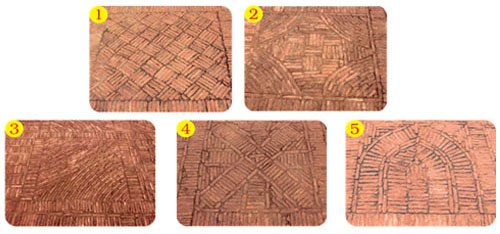
A brick has six rectangular faces and only three of its faces are visible in a drawing. Therefore, we can’t draw a brick that shows 4 of its faces.
Make a drawing of this box to show 3 of its faces.

A drawing of the box which shows its three faces is:

Here are the photos of three kinds of brick walls. Can you see the difference in the way the bricks are placed?

The drawing of the given brick walls shown below shows the different ways in which the bricks are arranged.

Which floor pattern do you like the most?

Observe the given floor patterns and mention the one you like the most. The answer may vary from student to student
Have you seen such patterns anywhere?
Recall if you have seen any such floor patterns and answer accordingly. The answer may vary from student to student
Which pattern is made in a circle?

A circle is a round-shaped figure with no corners or edges. Observe the floor patterns in the picture. Therefore, the pattern J is made in a circle.
In which pattern can you show mirror halves? Draw a line.
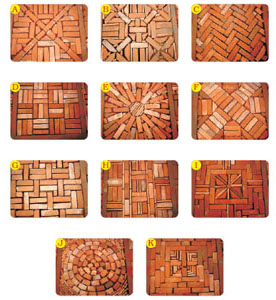
An image has mirror halves if it can be divided by a straight line into two similar images. Patterns A, B, H, and I have mirror halves.:

Now you draw some new floor patterns
Answer may vary. Do it by yourself. Some floor patterns are shown below:

How to draw a brick?
A brick is a type of block which has six rectangular faces. The drawing of a brick is shown below.

How many faces in all does a brick have?
A brick is a type of block which has six rectangular faces. Therefore, a brick has six faces in all.
Is any face a square?
No, the face of a brick is not a square. Faces of a brick are rectangular in shape.
Draw the smallest face of the brick?
The smallest face of the brick is:

Which of these are the faces of a brick? Mark a ()

Faces of a brick are rectangular in shape. Therefore, the correct answer is:

Now match the photo of each wall with the correct drawing below:

The correct answer is:

How many different ‘jaali’ patterns can you see in these two photos?

Jaali patterns are the holes in a wall made in a pattern. Five different patterns of jaali are seen in the given photos
Now colour some bricks red and make your own ‘jaali’ patterns in the wall drawn below.
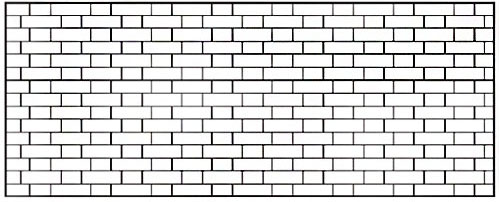
Colour some of the block red to make a new jaali pattern of your choice. Answers may vary. One example is:

Now draw some jharokha patterns on the wall here. You can shade it black.

Jharokha are the different patterns of windows. Shade the block with black to draw your jharokha pattern. Answers may vary. One example is:

Have you seen arches in a bridge? Where else have you seen an arch?

An arch is a curved structure. The image below shows an arch in a bridge
A rainbow is also in the shape of an arch. Answer based on your experience. Answers may vary.

Isn’t the ‘jaali’ of this window beautiful?
Answer based on your observation. Answers may vary. A sample answer is:
Yes, the jaali of the window is very beautiful.
How many faces do you see of the longest brick?.
Observe the longest brick. Only two faces are visible.
Is there any brick which has more than six faces?
A brick has six rectangular faces. Therefore, a brick cannot have more than six faces.
Have you seen bricks of different sizes? Take one brick and measure it.
a. How long is it?
b. How wide is it?
c. How high is it?
The bricks are of different sizes.
a. Use a ruler to measure the length of a brick. Answers may vary. Approximately bricks are 20 cm long.
b. Use a ruler to measure the breadth of a brick. Answers may vary. Approximately bricks are 8 cm wide.
c. Use a ruler to measure the height of a brick. Answer may vary. Approximately bricks are 1 cm high.
Muniya wants to make a wall 1 meter long. How many bricks will she need to put in a line?
Step 1: Consider the length of a brick as 20 cm. The relationship between metres and centimetres is 1 m = 100 cm. Therefore, Muniya wants to make the wall 100 cm long.
Step 2: Divide 100 by 20 to obtain the number of bricks she needs to put in a line.
100 ÷ 20 = 5
Therefore, 5 bricks are required.
Can you guess how high is the chimney here? Is it:
a. about 5 meters?
b. about 15 meters?
c. about 50 meters?
Observe the height. 5 meters and 15 meters are very small heights in comparison to the height of a chimney. So, it should be 50 meters. Hence, the height of the chimney is about 50 meters.
Here are four pictures from the brick kiln. These pictures are jumbled up. Look at them carefully.
Write the correct order. __________

The process of making a brick are the following:
● Collect the soil dug from the earth.
● Mould the soil in the shape of a cuboidal.
● Keep each of them separately leaving some spaces to dry.
● Arrange each brick one above the other. The correct order is C, D, B, and A

How do you think a brick is made out of soil dug from the earth? Look at the pictures and discuss in groups.
The process of making a brick is:
- Collect the soil dug from the earth.
- Mould the soil in the shape of a cuboidal.
- Keep each of them separately leaving some spaces to dry.
- Arrange each brick one above the other
Have you seen a brick kiln? Did you try to guess the number of bricks kept there?
Answer the question based on your observation. Answer may vary. A sample answer is: Yes, I have seen a brick kiln. There are many bricks placed together.
Can you try to write one lakh?
The number one lakh has 5 zeros after 1. It is written as 1,00,000.
Ask your friends where they have heard of a lakh?
Answer the question based on the responses from your friends. Answers may vary. The number one lakh is used to express a bigger number. You may hear one lakh in describing the population of a city or in terms of money.
Look at these photos and guess how many bricks are carried by this truck. Also find out from a trunk driver how many bricks they can carry in one truck.
Answer it based on your observation. Answers may vary It can be observed that they are more than thousands of bricks in the given photos. In general, a truck can carry approximately 4000 bricks.
Look at these photos and guess how many bricks are carried by this truck. Also find out from a trunk driver how many bricks they can carry in one truck.
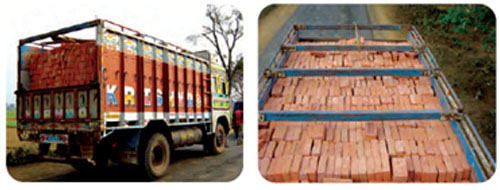
Answer it based on your observation. Answers may vary It can be observed that they are more than thousands of bricks in the given photos. In general, a truck can carry approximately 4000 bricks.
Guess what he will pay if he buys 500 old bricks
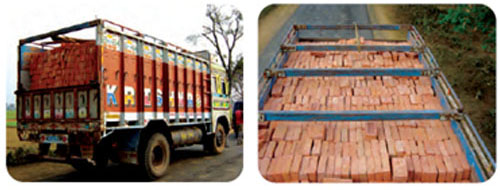
The cost of one thousand old brick is Rs 1200. Divide 1200 by 2 to get the cost of 500 old bricks.
1200 ÷ 2 = 600
Therefore, he has to pay Rs 600.
Which of these bricks have curved edges?

The edges are said to be curved if it is rounded. The second and third bricks from the top left corner have curved edges. The images of the curved edges bricks are:




Bhajan went to buy bricks. The price was given for one thousand bricks. The prices were also different for the different types of bricks.


Bhajan decided to buy the new bricks from Brickabad. He bought three thousand bricks. How much did he pay?

The cost of one thousand new bricks from Brickabad is Rs 2000. Multiply 2000 by 3 to get the cost of three thousand new bricks.
2000 × 3 = 6000
Therefore, Bhajan paid Rs 6000.
Frequently Asked Questions
The NCERT solution for Class 4 Chapter 1 - Building with Bricks is important as it provides a structured approach to learning, ensuring that students develop a strong understanding of foundational concepts early in their academic journey. By mastering these basics, students can build confidence and readiness for tackling more difficult concepts in their further education.
Yes, the NCERT solution for Class 4 Chapter 1 - Building with Bricks is quite useful for students in preparing for their exams. The solutions are simple, clear, and concise allowing students to understand them better. They can solve the practice questions and exercises that allow them to get exam-ready in no time.
You can get all the NCERT solutions for Class 4 Maths Chapter 1 from the official website of the Orchids International School. These solutions are tailored by subject matter experts and are very easy to understand.
Yes, students must practice all the questions provided in the NCERT solution for Class 4 Maths Chapter 1 - Building with Bricks as it will help them gain a comprehensive understanding of the concept, identify their weak areas, and strengthen their preparation.
Students can utilize the NCERT solution for Class 4 Maths Chapter 1 effectively by practicing the solutions regularly. Solve the exercises and practice questions given in the solution.

